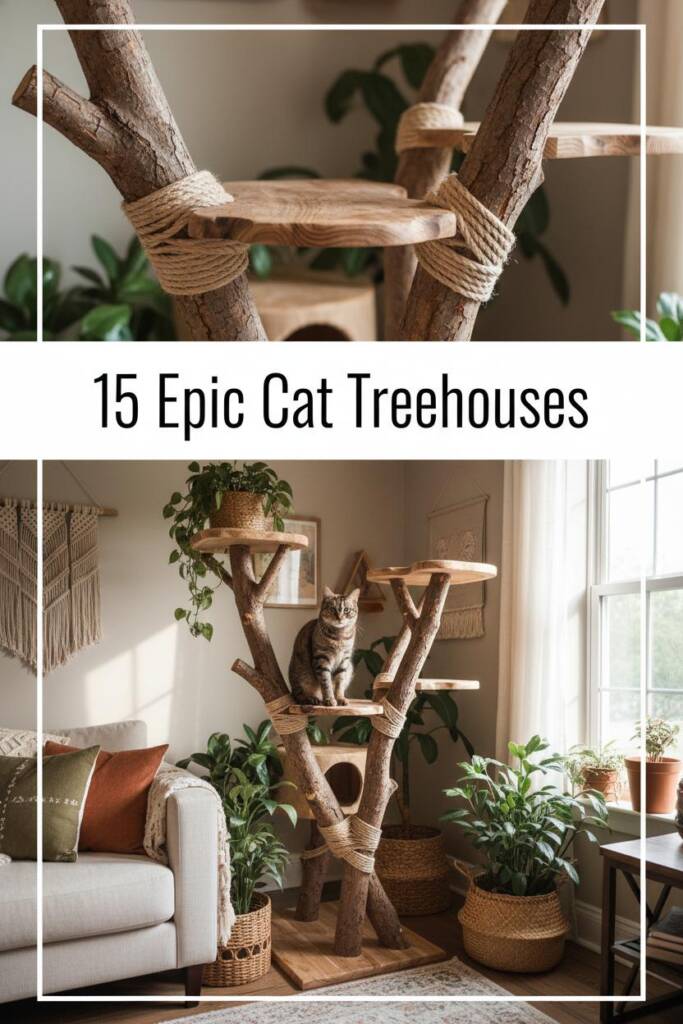
Your cat spends hours staring out windows, perching on the back of your couch, or claiming the highest bookshelf as their personal throne. They’re not just being quirk, they’re following their natural instinct to climb, observe, and own their vertical territory. Cat trees have always been a favorite for this reason: they’re practical, fun, and, when done right, can actually enhance your home instead of sticking out like old-school pet furniture.
But what if you could take that idea even further?
Enter the DIY cat treehouse: a game-changing fusion of functional cat furniture and stunning home décor that gives your feline the adventure playground they crave. Some designs echo the classic cat tree look, but the real magic happens when you go beyond it, creating a true “treehouse” experience, whether indoors or out.
These aren’t your standard carpet-covered towers from the pet store. We’re talking about architectural masterpieces that’ll have your guests doing double-takes and your cat living their absolute best life. Whether you’re working with a cozy apartment or a sprawling backyard, these treehouse ideas will inspire you to build something truly spectacular.
1. The Multi-Level Window Perch Treehouse
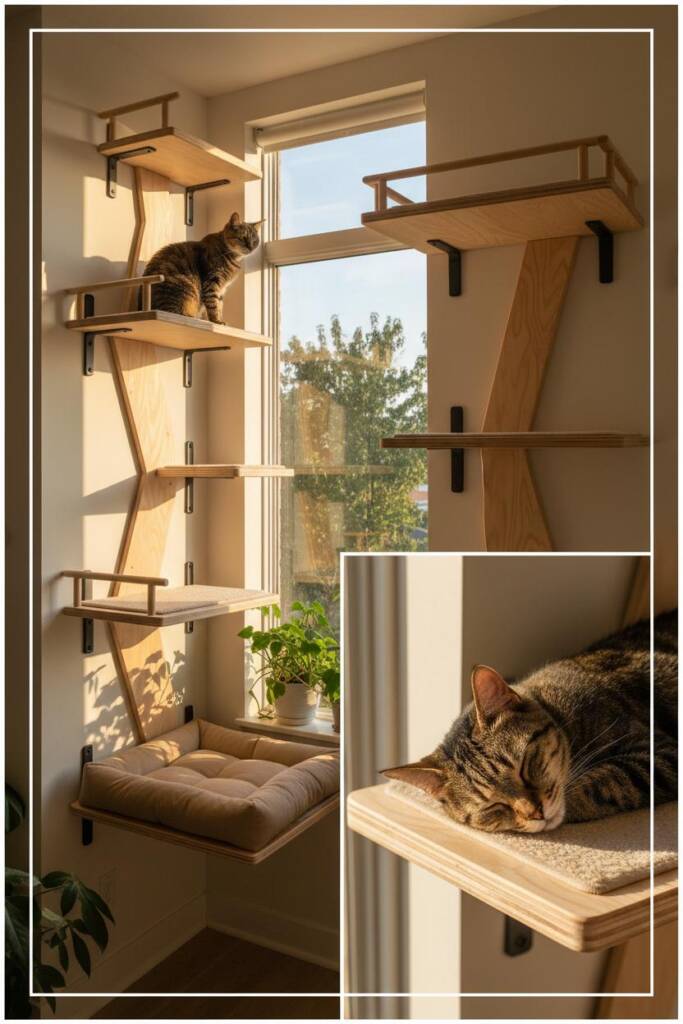
What Makes This Special
Window real estate is prime territory in the feline world, and this design capitalizes on every inch of it. Instead of a single window perch that leaves your cat fighting for space, this multi-level system creates a cascading staircase of platforms that turns your window into a vertical cat paradise.
The genius lies in how it maximizes natural light exposure while giving your cat multiple vantage points at different heights—perfect for surveying their kingdom or basking in those golden afternoon sun rays.
Key Design Elements
Start with a sturdy base platform mounted just below your windowsill, then build upward with progressively smaller platforms staggered on either side. Use solid wood boards (pine or plywood work beautifully) secured with heavy-duty L-brackets anchored directly into wall studs. The platforms should be carpeted or wrapped in sisal for grip and comfort.
Add small side rails on the outer edges for security, especially on higher platforms. The spacing between levels should be 12-18 inches to make jumping comfortable for cats of all ages and abilities. Consider adding a small hammock or cushioned bed on the largest platform for maximum lounging potential.
Perfect For
This design is ideal for apartment dwellers or anyone with limited floor space who wants to give their cat vertical territory without sacrificing square footage. It works especially well for multiple-cat households since the various levels prevent territorial disputes—each cat can claim their preferred height.
Senior cats will appreciate the graduated steps that make reaching the top easier than a single jump, while younger, energetic cats will love the parkour possibilities. If you have a window with a great view of bird feeders or street activity, this becomes an all-day entertainment center that’ll keep your cat engaged and mentally stimulated.
2. The Floating Shelf Skywalk System

What Makes This Special
If minimalist modern design makes your heart sing, this treehouse concept will blow your mind. The floating shelf skywalk creates an aerial highway around your room that looks more like contemporary art installation than cat furniture.
Your feline literally walks on air (or appears to), moving gracefully along clean-lined platforms that seem to defy gravity. The beauty is in its simplicity—no bulky towers, no carpet-covered monstrosities, just sleek platforms that blend seamlessly with your existing decor while giving your cat an elevated path to explore.
Key Design Elements
Choose floating shelves in wood tones or colors that complement your wall color and existing furniture. Start by mapping out a pathway around your room—think about creating a circuit that lets your cat travel from one side to another without dead ends. Mount shelves at varying heights (18-24 inches apart vertically works well) to create natural stepping stones.
Each shelf should be at least 10-12 inches deep to give cats confident footing. Install them into wall studs using heavy-duty floating shelf brackets rated for at least 30-50 pounds. Add texture to each platform by attaching thin carpet tiles or cork sheets on top—this prevents slipping and gives claws something to grip. For extra flair, incorporate corner shelves, curved platforms, or even small carpeted steps between larger gaps.
Perfect For
This system shines in modern, contemporary, or Scandinavian-style homes where aesthetics matter as much as functionality. It’s perfect for renters who want something that looks intentional rather than like temporary pet furniture—when installed properly, it reads as part of your interior design.
The skywalk works brilliantly in living rooms, home offices, or bedrooms where you want your cat to have access to high spaces without blocking sightlines or creating visual clutter. Solo cats or bonded pairs do especially well with this setup since the narrow pathways encourage single-file traffic. If you love the idea of your cat being able to survey the entire room from above while you maintain that clean, uncluttered aesthetic, this is your winner.
3. The Spiral Staircase Cat Tower
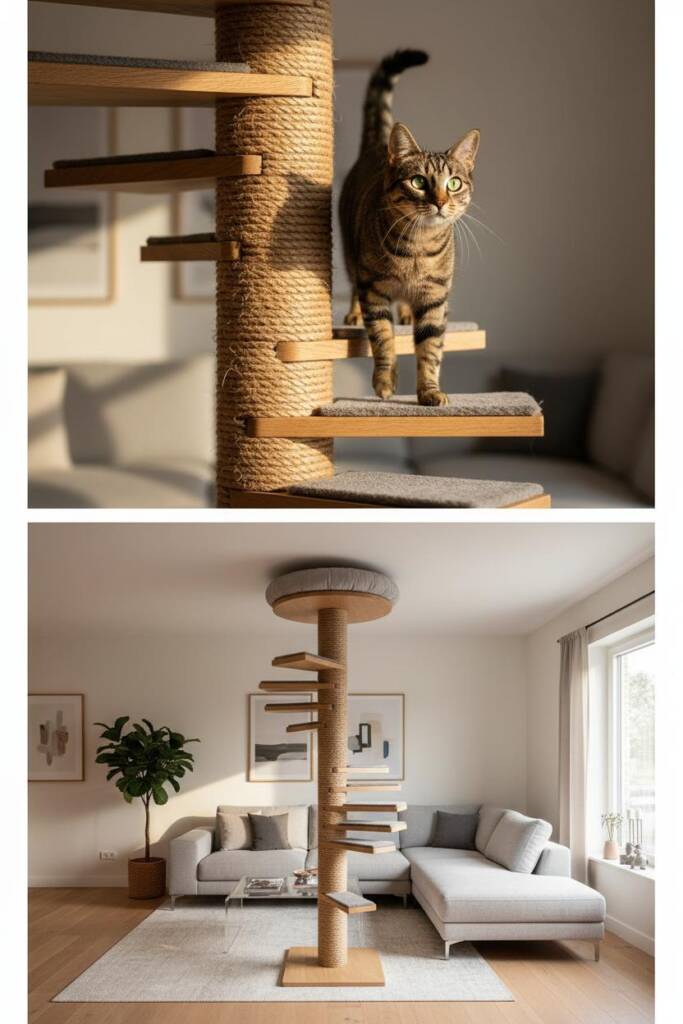
What Makes This Special
Prepare for this to become the conversation starter in your home. The spiral staircase cat tower is architectural drama meets feline functionality—a twisting, ascending pathway that guides your cat upward in a mesmerizing circular climb.
Unlike straight towers that feel predictable, the spiral creates visual interest from every angle and turns the journey to the top into an adventure. Your cat doesn’t just climb; they ascend with style. The continuous curve also feels more natural to cats, mimicking the way they’d circle around a tree trunk in the wild.
Key Design Elements
Build this around a central pole (a 4×4 wooden post or sturdy PVC pipe works perfectly) that extends from floor to ceiling. Create wedge-shaped platforms that wrap around the pole in a ascending spiral pattern, spacing them 8-10 inches apart vertically.
Each platform should be roughly 10-14 inches deep at its widest point. Secure platforms with wood screws driven through pre-drilled holes into the central pole, and add L-brackets underneath for extra support. Wrap the central pole with sisal rope for scratching, and carpet each platform tread.
The spiral should complete 1.5 to 2 full rotations from bottom to top. Add a large circular platform or cushioned bed at the summit as the ultimate reward for the climb. For extra stability with taller towers (over 6 feet), use a ceiling tension rod or secure the top to a ceiling beam.
Perfect For
This showstopper works best when you have ceiling height to play with—8-foot ceilings or higher make the spiral really shine. It’s perfect for that empty corner in your living room, bedroom, or even a spacious hallway that feels underutilized. Active, athletic cats will absolutely thrive with this design since it engages their climbing instincts and provides a true vertical challenge.
If you have a cat who loves to be at the highest point possible (we’re talking ceiling-level supremacy), this delivers that experience while looking like custom furniture rather than a cat tower. It also works wonderfully as a room divider in open-concept spaces, creating visual separation without blocking light or closing off the area completely.
4. The Geometric Box Treehouse Complex
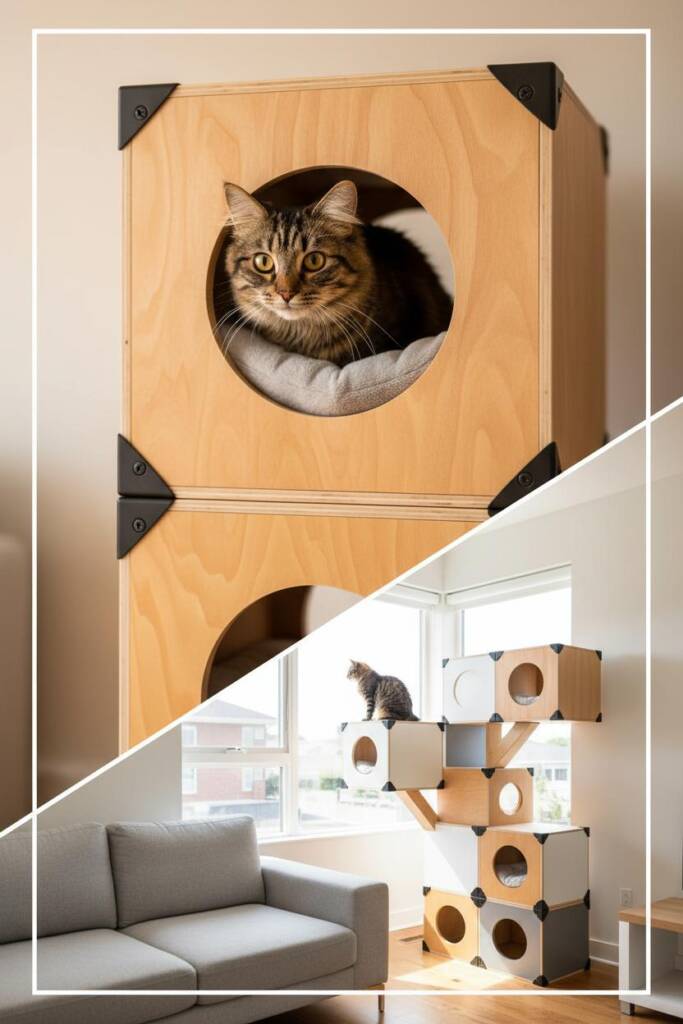
What Makes This Special
Think modular, think modern, think Tetris for cats. This geometric box design stacks cube-shaped modules in an eye-catching configuration that looks like it belongs in a contemporary design magazine. Each box serves as a hideaway, perch, or pass-through tunnel, and the asymmetrical stacking creates natural platforms at different heights.
The genius of this system is its flexibility—you can reconfigure the boxes, add more modules over time, or adapt the layout as your cat’s preferences change. It’s functional art that grows with your needs.
Key Design Elements
Build or purchase cube boxes (15-18 inches per side works well) from plywood, leaving one or two sides open for entry. Paint them in complementary colors or natural wood stains to match your decor. Stack and secure them in an offset pattern—think architectural, not symmetrical—using wood glue and screws where boxes connect. Some cubes should have circular entrance holes (8-10 inches diameter) cut into sides, while others remain open.
Add carpet or cushions inside select boxes to create cozy sleeping nooks. Incorporate flat-topped boxes as jumping platforms and observation decks. Mount the entire complex against a wall using L-brackets for stability, or create a freestanding tower by ensuring the base is wide and heavy. The beauty is in the randomness—offset angles, varying heights, and unexpected openings create visual intrigue.
Perfect For
Modern and contemporary homes will embrace this design instantly. It’s ideal for creative spaces, home offices, or even kids’ rooms where playful design is celebrated. Multi-cat households benefit enormously from this setup since multiple boxes mean multiple hiding spots, perches, and pathways—reducing territorial tension.
Shy or anxious cats love having enclosed boxes to retreat into, while curious cats enjoy exploring the various entrances and exits. If you’re someone who likes to refresh your space periodically, the modular nature means you can rearrange boxes seasonally or add new colors and configurations without starting from scratch. It’s also surprisingly renter-friendly if you build it as a freestanding unit rather than wall-mounted.
5. The Rustic Branch and Platform Paradise
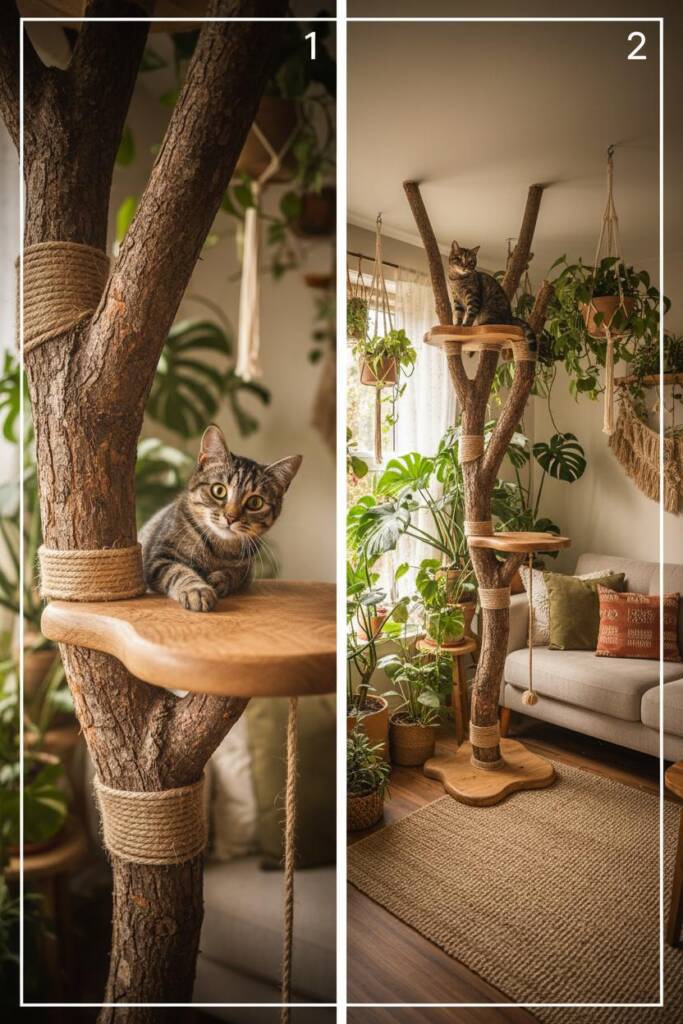
What Makes This Special
Bring the forest indoors with this organic, nature-inspired treehouse that uses real tree branches as the climbing structure. There’s something deeply satisfying about watching your cat navigate actual branches—it taps into their wild ancestry while creating a living sculpture in your home.
The irregular shapes and natural textures of real wood provide authentic scratching surfaces and unpredictable pathways that keep cats engaged far longer than uniform, manufactured alternatives. Plus, it’s an eco-friendly option that transforms fallen branches into functional art.
Key Design Elements
Source sturdy hardwood branches (oak, maple, or birch) that are 2-4 inches in diameter—check your own yard after storms, ask tree trimming services, or scout parks (with permission). Clean and dry branches thoroughly, then treat with pet-safe sealant to preserve them.
Mount horizontal branches to your wall using heavy-duty brackets or floor flanges, ensuring they’re secured into studs. Position branches at varying heights and angles to create a natural climbing path. Add flat wooden platforms (12-15 inches wide) at strategic points along the branch pathway, securing them with L-brackets. These platforms serve as rest stops and observation decks.
Leave bark intact for authentic texture. Connect multiple branches at different heights with rope bridges or smaller connecting branches to create pathways. Add hanging rope toys or sisal-wrapped sections for extra engagement.
Perfect For
This design sings in homes with rustic, bohemian, farmhouse, or eclectic decor where natural elements are celebrated. It’s perfect for nature lovers who want to blur the line between indoors and outdoors.
Cats who show strong hunting and climbing instincts will gravitate to this instantly—the irregular surfaces and varying branch thicknesses challenge their balance and coordination in ways flat platforms can’t match.
If you have an indoor cat who seems to yearn for outdoor adventures, this brings a taste of the wild inside safely. The design also works beautifully in sunrooms, enclosed porches, or any space where bringing natural elements indoors enhances rather than clashes with your aesthetic vision.
6. The Built-In Wall Niche Cat Castle
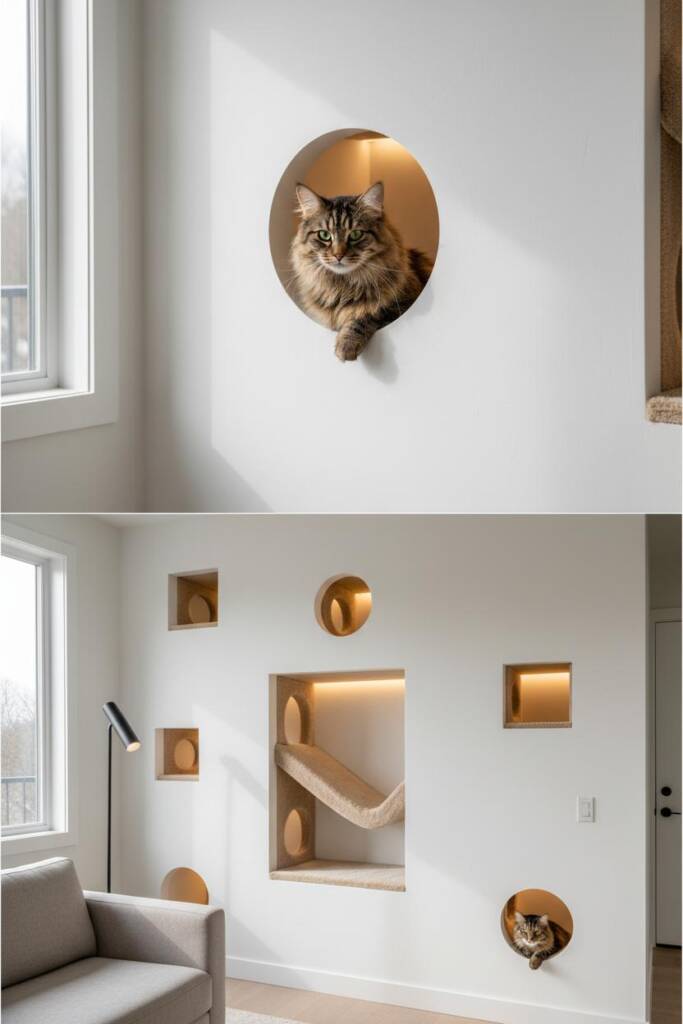
What Makes This Special
This is next-level commitment to cat luxury—literally building secret passages and rooms into your walls. If you’re renovating, building new, or have access to wall cavities, this design transforms dead space into a hidden feline fortress.
Imagine your cat disappearing into a small entrance hole and navigating through tunnels, chambers, and peek-a-boo windows within your actual walls. It’s the ultimate conversation piece and provides your cat with private territory that feels truly theirs. The built-in nature also means zero floor space used and a completely custom experience.
Key Design Elements
This requires access to wall studs and cavities (easiest during construction or renovation). Cut entrance holes (10-12 inches diameter) into drywall between studs. Inside the wall cavity, install carpeted platforms, small shelves, or cushioned nooks using brackets secured to studs.
Create tunnels by connecting multiple wall cavities—carefully cut through studs where needed (consult a contractor for load-bearing walls) or route around them. Add small windows (4-6 inch circles) at various points so cats can peek out and you can see in. Install battery-operated LED strip lights inside for visibility and ambiance.
Carpet all interior surfaces for comfort and sound dampening. Create multiple entrance/exit points in different rooms to form a secret highway through your home. Ensure adequate ventilation and easy access panels for cleaning.
Perfect For
This is for the ultimate cat enthusiast who’s planning renovations or building a new home and wants to incorporate cat infrastructure from the ground up. It’s perfect if you love the idea of hidden features and secret passages—your home becomes an interactive adventure for your cat.
Multi-level homes benefit especially since you can create vertical tunnels through floors (with proper support). If you have skittish cats who need safe retreat spaces away from dogs, kids, or visitors, built-in niches provide unparalleled security.
This also works brilliantly in small homes where floor space is precious—your cat gets an entire territory without any furniture footprint. Just know this requires planning, some construction knowledge, and isn’t renter-friendly unless you’re exceptionally dedicated.
7. The Bookshelf Cat Treehouse Hybrid
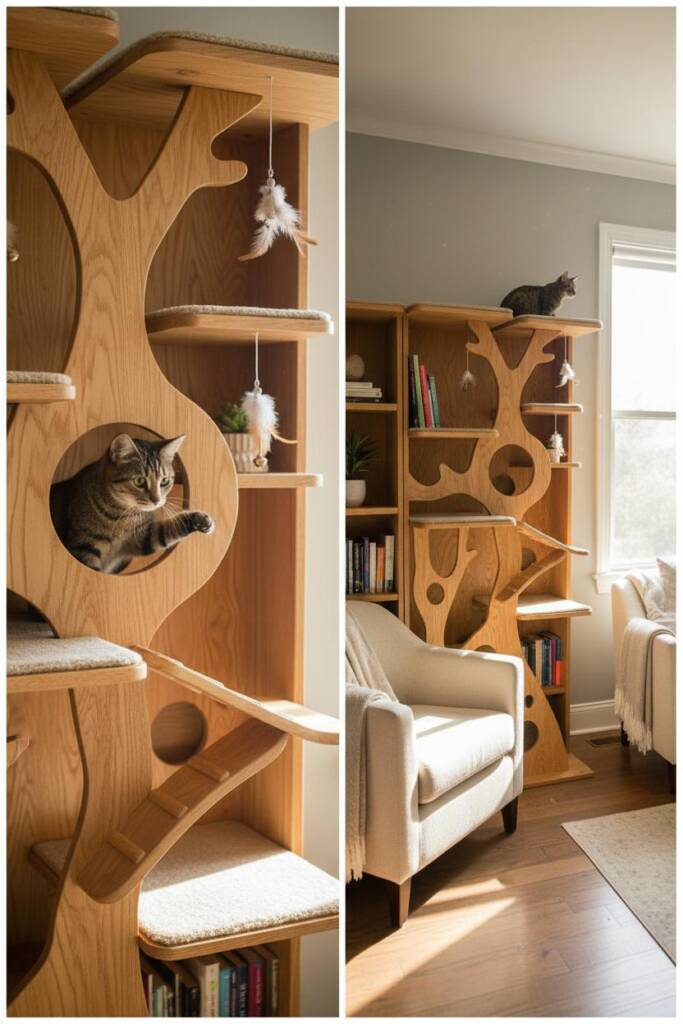
What Makes This Special
Why choose between storage and cat furniture when you can have both? This dual-purpose design integrates cat walkways, perches, and hideaways directly into a functional bookshelf unit.
Your books, plants, and decor items share space with cat platforms, creating a living library that serves both human and feline needs. The seamless integration means your cat furniture doesn’t look like an afterthought—it’s woven into the fabric of your home organization. Plus, cats absolutely love weaving between books and claiming shelves as their personal domains, so you’re working with their natural inclinations.
Key Design Elements
Start with a tall, sturdy bookshelf unit (at least 5-6 feet high)—either purchase one with adjustable shelves or build custom. Remove or adjust certain shelves to create open vertical pathways that cats can climb through. Leave some standard shelves for books but dedicate alternating levels to cat platforms.
Add carpeted or cushioned platforms at various heights, secured with L-brackets. Cut circular entrance holes (8-10 inches) into the backs or sides of closed cabinet sections to create hidden sleeping nooks behind books. Install small ramps or carpeted steps between levels that are too far apart for comfortable jumping. Incorporate hanging toys or feather wands from upper shelves.
Consider adding a scratching post element by wrapping one vertical support with sisal rope. The key is balancing storage functionality with clear cat pathways—you want it to look intentional, not cluttered.
Perfect For
This is brilliant for small apartments, studios, or home offices where every piece of furniture needs to earn its keep. Book lovers and academics will appreciate keeping their collection while accommodating their cat’s needs in one consolidated unit. It works especially well for calm to moderately active cats who enjoy observing from medium heights rather than extreme athletic climbers who want to scale walls.
If your aesthetic leans toward cozy, intellectual, or eclectic spaces filled with personal collections, this fits seamlessly. The hybrid design also gives shy cats plenty of hiding spots—they can retreat behind books when overwhelmed but still be near you. For renters, a freestanding unit means you’re not modifying walls, making this a portable solution you can take to your next place.
8. The Corner Climbing Tower with Hammock Lounges

What Makes This Special
Corners are the forgotten real estate of most rooms—awkward spaces where furniture doesn’t quite fit and dust bunnies gather. This design transforms that wasted triangular space into a floor-to-ceiling cat paradise packed with climbing opportunities and luxurious lounging spots.
The corner placement provides inherent stability (two walls for support instead of one) while the hammock elements add that coveted swaying, cocooned feeling cats can’t resist. It’s space-efficient vertical design at its finest, turning a nothing zone into your cat’s favorite everything zone.
Key Design Elements
Build the frame using 2×4 lumber to create a triangular tower that fits snugly into your corner from floor to ceiling. Secure it to both walls and use a ceiling tension system for rock-solid stability. Install platforms at staggered heights (10-15 inches apart) cut to fit the triangular footprint—these can be plywood or solid wood boards.
Wrap the vertical support posts with sisal rope for scratching surfaces. Here’s where it gets cozy: stretch fabric hammocks between platforms at 2-3 levels. Use heavy-duty canvas, denim, or even upcycled jeans fabric, securing each hammock with grommets and eye hooks screwed into the frame.
The hammocks should have some sag (4-6 inches) to cradle your cat comfortably. Add carpet or foam padding to solid platforms. Include at least one enclosed cube hideaway at a mid-level for privacy. Top it off with a large cushioned platform where your cat can survey their domain.
Perfect For
This corner tower is ideal for maximizing small spaces—think studio apartments, compact bedrooms, or any room where you’re already tight on square footage. Multi-cat households particularly benefit since the vertical layers naturally separate cats who want different elevation levels, reducing competition.
Cats who love to knead and nest will become obsessed with the hammocks—the fabric gives them something to biscuit-make on while the gentle sway mimics the security of being cradled.
Senior cats appreciate having multiple rest stops on the climb up, while the hammocks provide joint-friendly suspended sleeping that takes pressure off aging hips. If you’re working with an oddly shaped room or awkward architectural features, corner towers turn those challenges into advantages.
9. The Under-Stairs Cat Mansion

What Makes This Special
That triangular void beneath your staircase has been silently begging for purpose, and this design answers that call spectacularly. Converting under-stair space into a cat mansion creates a multi-room dwelling that feels like a secret hideout—cats adore enclosed spaces with single entry points where they can control who comes and goes.
The sloped ceiling created by the stairs above provides natural height variation, allowing you to build multiple “floors” within the space. Best of all, this keeps cat furniture completely out of your main living areas while giving your feline an entire private estate.
Key Design Elements
Start by clearing out the under-stair space completely. Install a decorative door or cut an arched entrance (12-14 inches wide) at the base—make it attractive since it’ll be visible in your hallway or living area. Inside, build a multi-level structure using the stair slope to your advantage: create a ground-level room, mid-level platforms, and higher perches that follow the ascending staircase above.
Use plywood to construct walls that divide the space into 2-4 rooms depending on your staircase size. Cut doorways and windows between rooms for flow. Carpet all interior surfaces for comfort and sound absorption. Add small cushions or beds in each “room.” Install battery-powered LED puck lights or a small plug-in lamp to illuminate the space. Include scratching posts or sisal-wrapped supports.
If space allows, incorporate a small ramp or steps. Consider adding mesh or fabric across one wall section to create a peek-through window so your cat can see out while feeling secure.
Perfect For
This is perfect for homeowners with accessible under-stair storage who want to repurpose wasted space into something functional and charming. Multi-cat households will love this since the multiple rooms allow cats to coexist without constant visual contact—each can claim their own chamber.
Nervous or shy cats who need a quiet retreat away from household chaos will particularly thrive with this setup. It’s also excellent for homes with dogs, young children, or frequent visitors where your cat needs a guaranteed safe zone that’s off-limits to others.
If you appreciate hidden features and clever space utilization, this project delivers serious satisfaction. The under-stair mansion keeps your main rooms clutter-free while still providing extensive cat territory.
10. The Rope and Platform Adventure Course

What Makes This Special
This isn’t just a treehouse—it’s an American Ninja Warrior course for cats. The rope and platform adventure system emphasizes active play and physical challenges, incorporating climbing ropes, suspended bridges, rope ladders, and swinging elements that engage your cat’s athletic abilities.
Every element moves or requires balance, keeping even the most energetic cats mentally and physically stimulated. The nautical-inspired aesthetic brings a playful, adventurous vibe to your space, and watching your cat master increasingly difficult elements is endlessly entertaining.
Key Design Elements
Build a framework of solid platforms mounted to your wall at various heights—these serve as anchor points and rest stations. Between platforms, install challenge elements: thick sisal rope (1/2 to 3/4 inch diameter) knotted at intervals for climbing, rope bridges made from parallel ropes with wooden slat steps, rope ladders secured top and bottom, and even suspended platforms that swing gently. Use marine-grade rope or sisal for durability.
Secure all rope elements with heavy-duty eye bolts screwed into wall studs and platform frames. Platforms should be 12-15 inches square minimum, giving cats confident landing zones. Wrap vertical support posts with rope for traditional climbing. Add a few hammock-style rope nets where cats can rest between challenges. Include at least one solid enclosed box at mid-height for cats who need a break from the action. Vary the difficulty—some direct platform-to-platform jumps, some rope-assisted climbs, some wobbly bridge crossings.
Perfect For
This course is designed for high-energy, athletic cats who get bored easily with standard cat furniture. Bengals, Abyssinians, young cats, and any feline with excess energy will absolutely thrive here. It’s ideal for homes where you want to provide serious enrichment that burns physical and mental energy—tired cats are happy cats.
If you have a playroom, basement, garage conversion, or bonus room where an adventurous aesthetic fits, this creates a dedicated cat zone that feels purpose-built. It also works beautifully for solo cats who need stimulation when you’re away—the varying elements provide novelty that holds attention. Just ensure your cat is physically capable before building advanced features; senior cats or those with mobility issues need gentler alternatives.
11. The Real Tree Integration Treehouse
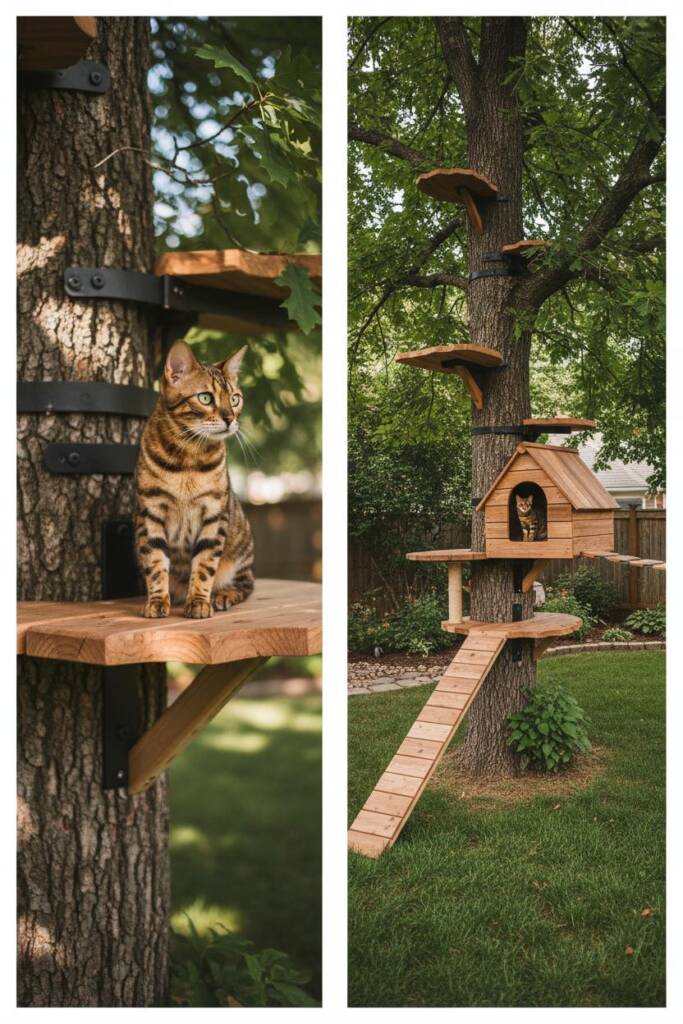
What Makes This Special
Why build an artificial tree when you can use the real deal? This outdoor design incorporates an actual living tree in your yard as the structural foundation for a magnificent cat treehouse.
There’s something magical about watching your cat climb authentic bark, navigate real branches, and lounge on platforms nestled among actual leaves. The tree provides natural shade, authentic textures, and a genuinely enriching outdoor experience. Plus, it’s arguably the most environmentally friendly option—you’re enhancing what nature already provided rather than consuming new materials.
Key Design Elements
Select a healthy, mature tree with strong branches—hardwoods like oak, maple, or ash work best. Consult an arborist to identify which branches can safely support platforms without damaging the tree. Use tree-friendly attachment methods: platform brackets that don’t penetrate deeply, straps around branches instead of nails, or suspension systems from higher branches.
Build platforms (18-24 inches square) from weather-resistant wood like cedar or pressure-treated lumber. Position platforms at varying heights (3-6 feet works for most cats) near sturdy branch intersections. Add ramps or ladder-style steps between levels for easy navigation.
Wrap jute or sisal rope around the main trunk for climbing. Include at least one covered shelter at a mid-level height for weather protection and security—a simple wooden box with a sloped roof works perfectly. Ensure all platforms have raised edges or rails to prevent falls. Create multiple access points: a ground-level ramp, steps from a nearby fence, or a bridge from a window or deck.
Perfect For
This is ideal for homeowners with cat-friendly yards and healthy trees. Cats who show interest in outdoor time but need to remain safe from predators, traffic, and other dangers will flourish here. It works especially well when combined with a catio or enclosed yard, though supervised outdoor time works too.
If you have a cat who was formerly outdoor but now indoor-only, this provides a compromise that satisfies their wild instincts. Tree integration is also perfect for nature enthusiasts who want outdoor structures that enhance rather than detract from their landscape. Consider local wildlife—if you have aggressive predators in your area, ensure platforms are high enough and include enclosed safe zones. The tree treehouse brings genuine outdoor enrichment to indoor cats while keeping them safe.
12. The Elevated Garden Gazebo Cat Retreat

What Makes This Special
This outdoor treehouse is as much a garden feature as it is cat furniture—a miniature gazebo structure that elevates both your landscaping and your cat’s outdoor experience. The elevated design lifts your cat above ground-level threats while providing 360-degree views of the yard.
The gazebo roof offers weather protection, making it functional rain or shine. From your perspective, it’s an attractive focal point that enhances your outdoor space; from your cat’s perspective, it’s the ultimate observation tower for monitoring birds, butterflies, insects, and everything happening in their outdoor kingdom.
Key Design Elements
Build a raised platform (3-4 feet off the ground) approximately 4×4 feet square using pressure-treated lumber or cedar for the frame and decking. Support it with four sturdy corner posts (4×4 lumber) anchored in concrete footings for stability. Top the platform with a pitched roof structure—either a four-sided pyramid roof or a traditional two-sided gable. Use weather-resistant roofing material like shingles, metal sheeting, or waterproof fabric.
Leave the sides open for airflow and views, but add decorative railings (3-4 inches high) around the platform edge for safety. Include a ramp or staircase for access. Install outdoor carpet, artificial grass, or rubber matting on the platform surface for comfort and grip.
Add a weatherproof cushion or cat bed in one corner. Consider incorporating a small enclosed box within the gazebo for additional security. Paint or stain the wood to match your home’s exterior or garden aesthetic. Surround the base with cat-safe plants like catmint or cat grass for extra sensory enrichment.
Perfect For
This works beautifully in suburban or rural yards where you want outdoor cat furniture that looks intentional and attractive. Homeowners who take pride in their landscaping will appreciate how this structure enhances rather than detracts from the garden design. It’s perfect for cats who enjoy supervised outdoor time or for yards enclosed with cat-proof fencing.
The elevated position makes it suitable even for areas with small wildlife or curious dogs—your cat has a safe vantage point above ground disturbances. If you entertain outdoors, this becomes a charming conversation piece that demonstrates your commitment to your pet. The gazebo retreat also works well near patios or decks where you can add a connecting bridge, allowing your cat to access outdoor space without touching the ground.
13. The Catio Wonderland with Multi-Level Platforms
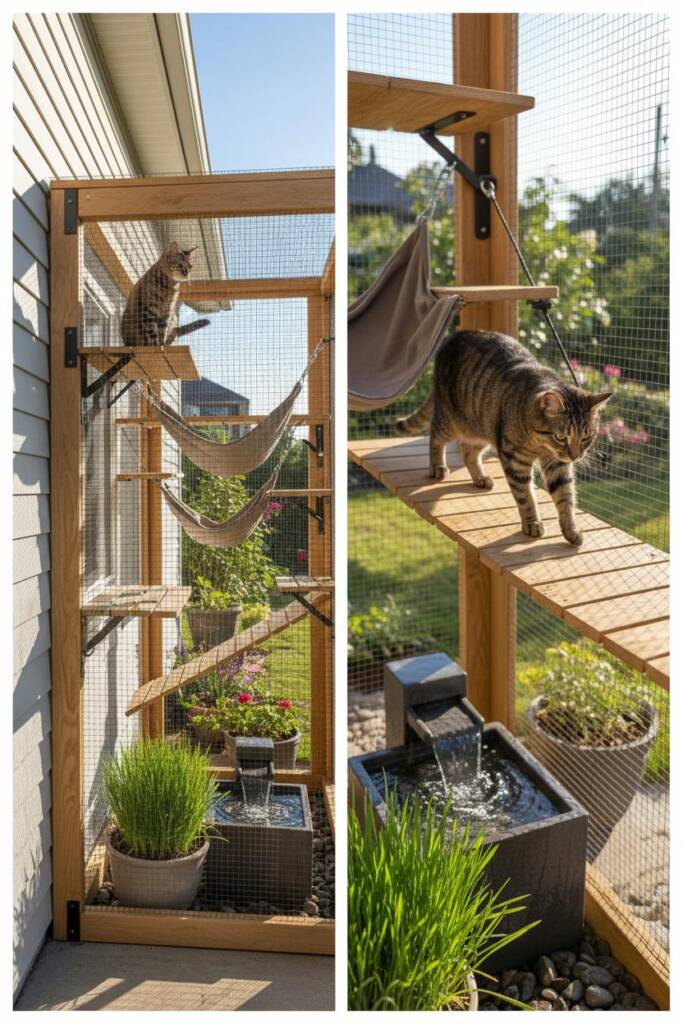
What Makes This Special
A catio takes outdoor time to the next level—a fully enclosed outdoor space where your cat can experience fresh air, sunshine, and nature without any of the dangers. This multi-level platform version transforms a basic enclosure into a vertical playground with climbing opportunities, lounging spots at different heights, and varied environments within one safe space.
It’s the ultimate compromise for cats who crave outdoors and owners who want to keep them safe from cars, predators, diseases, and getting lost. Once you build this, your cat will spend hours voluntarily choosing outdoor enrichment.
Key Design Elements
Start with a sturdy frame using 2×4 lumber to create the catio structure—size depends on available space, but even 6×8 feet provides excellent territory. Enclose all sides, top, and bottom (if elevated) with heavy-duty wire mesh or cat-proof screening (avoid chicken wire—cats can chew through it).
Attach the mesh using heavy-duty staples and secure with trim boards. Inside, build multiple platforms at various heights using weather-resistant plywood. Create pathways that encourage exploration: low platforms for lounging, mid-level perches for observing, and high platforms for superior vantage points.
Install ramps, steps, or branches between levels. Include diverse features: hanging hammocks, rope bridges, log sections for scratching, potted cat-safe plants (like catgrass or catnip), a small water feature or fountain (cats love the sound), and multiple covered hideaways for weather protection. Add outdoor carpet or artificial turf to some platforms for varied textures. Ensure proper drainage for rain. Include a cat door or tunnel connecting to your home for free indoor-outdoor access, or create a regular human door for supervised visits.
Perfect For
This is ideal for any cat owner who worries about outdoor dangers but wants to give their cat the outdoor experience they crave. Indoor cats who show window frustration, door-dashing behavior, or excessive energy often transform completely once they have catio access. It works in virtually any space—attach it to a window, door, or exterior wall; build it freestanding in your yard; or even create a balcony catio for apartment living.
Multi-cat households benefit enormously since the multiple levels and hiding spots reduce territorial tension. If you live in areas with predators, extreme weather, or busy roads, the enclosed safety is invaluable. The catio also protects local wildlife—your cat gets outdoor enrichment without impacting bird and small animal populations.
14. The Backyard Adventure Tower with Rope Bridges

What Makes This Special
This is the ultimate outdoor cat playground—a tall freestanding tower that rivals the height of real trees, complete with rope bridges connecting to secondary structures or your home. The adventure tower creates genuine climbing challenges and dramatic elevation that indoor structures simply can’t match.
Multiple cats can use it simultaneously without conflict since the sheer size provides ample territory. The rope bridges add an element of adventure and slight instability that engages balance and coordination. From a visual standpoint, it’s an impressive backyard feature that showcases your dedication to your cat’s enrichment.
Key Design Elements
Build the main tower using 4×4 posts as the primary supports, creating a structure 8-12 feet tall. Anchor posts in concrete footings buried 2-3 feet deep for stability. Create platforms at 2-3 foot intervals as you ascend—each platform should be 2×2 feet minimum. Use pressure-treated lumber or cedar for longevity. Wrap support posts with sisal rope or outdoor carpet for climbing surfaces.
Top the tower with a covered shelter (small roof) and large cushioned platform. Install rope bridges connecting the tower to other structures: a second smaller tower, your deck railing, a shed, or even a second-story window. Rope bridges should use thick marine-grade rope (3/4 inch or more) with wooden slat steps spaced 6-8 inches apart.
Secure bridges firmly at both ends using eye bolts and weatherproof hardware. Add ramps as alternative routes for less adventurous or senior cats. Include enclosed boxes or covered platforms at multiple heights for weather protection. Consider adding hanging toys, dangling ropes, or other interactive elements.
Perfect For
This tower is designed for outdoor-loving cats who have safe yard access and owners with space for substantial structures. It works brilliantly in enclosed yards or when combined with catios for secure outdoor time. Multi-cat households particularly benefit from the size and multiple pathways—cats can avoid each other or play together depending on mood.
Athletic, energetic cats will use this daily for exercise and enrichment. If you have a large property or rural setting, this structure lets your cat safely experience height and adventure without free-roaming risks. The tower also serves as a guardian post—cats naturally want to survey their territory from the highest point, and this delivers that experience. Just ensure your climate isn’t too harsh; extreme heat, cold, or frequent severe weather may limit use unless you add climate control elements.
15. The Zen Garden Cat Treehouse

What Makes This Special
This outdoor treehouse takes inspiration from Japanese garden design, creating a tranquil, nature-focused retreat that’s as calming for you to look at as it is enriching for your cat to explore.
Natural materials like bamboo, river rocks, sand, and wood create an aesthetic that feels intentional and meditative. The zen garden approach incorporates sensory elements—textures to walk on, plants to brush against, water sounds, and natural perches—that engage your cat’s senses in gentle, non-overwhelming ways. It’s outdoor cat furniture as landscape art.
Key Design Elements
Create a contained garden bed or raised platform area (6×6 feet or larger) as your foundation. Use natural stone or wood as borders. Inside, build elevated platforms at varying heights using bamboo poles as supports or natural wood logs. Keep platforms organic in shape rather than perfectly square—oval, irregular, or natural edge wood slabs work beautifully.
Add a small sand or fine gravel section where cats can dig or roll. Incorporate smooth river rocks of various sizes as pathway elements and texture variation. Plant cat-safe bamboo, ornamental grasses, or ferns around the perimeter for privacy and sensory engagement. Include a small water feature—a bamboo fountain or shallow dish with flowing water provides sound enrichment.
Add flat sun-warmed stones for lounging. Create shade areas using bamboo screening or plant canopy. Include one or two enclosed shelters designed to blend with the aesthetic—perhaps bamboo structures with roof covering. Use natural sisal rope wrapped around bamboo for climbing elements. Keep the overall design minimalist and harmonious rather than cluttered.
Perfect For
This design suits homeowners who value aesthetics as much as function and want outdoor cat spaces that enhance rather than disrupt landscape design. It’s perfect if you’re drawn to Asian-inspired gardens, minimalist outdoor spaces, or natural design principles.
Calm, contemplative cats who enjoy observation more than athletic climbing will particularly appreciate the zen garden’s gentle approach. It works beautifully adjacent to patios, meditation spaces, or viewing areas where you’ll enjoy observing both the garden and your cat within it.
If you have a smaller yard where large structures feel overwhelming, the zen garden’s ground-level, integrated design provides cat enrichment without dominating the space. It’s also ideal for senior cats who need accessible outdoor time without demanding climbs—the low platforms and natural elements provide enrichment without physical strain.
Everything You Need to Make Your Cat Treehouse Dreams Reality
You’ve got the vision, you’ve got the plan—now let’s talk about those finishing touches that transform a wooden structure into a cat paradise. These carefully chosen additions aren’t just accessories; they’re the difference between a treehouse your cat tolerates and one they absolutely live in. From cushioning those perches to adding sensory elements that keep things interesting, these items complete the experience and show your cat you’ve truly thought of everything.
Your Cat Treehouse Essential Shopping List
1. Orthopedic Pet Cushions in Multiple Sizes
Look for memory foam cushions with removable, machine-washable covers in sizes that fit your various platforms. These provide joint support for all-day lounging and are especially crucial for senior cats or high perches where your cat will spend extended periods. Choose water-resistant covers for outdoor treehouses and coordinating colors that complement your design aesthetic.
2. Textured Comfort Layers (Fleece Blankets, Faux Fur Throws, or Sherpa Pads)
Cats are texture connoisseurs, and adding soft, cozy layers to platforms creates irresistible napping spots. These also provide warmth during cooler months and can be easily swapped out seasonally or when washing. Choose materials that can be tossed in the washing machine—because cat hair happens. For outdoor structures, opt for outdoor-rated fabrics that resist moisture and mildew.
3. Interactive Hanging Toys and Feather Wands
Even the most spectacular treehouse benefits from toys that engage hunting instincts. Attach feather danglers, spring toys, or hanging balls at various levels to encourage play during climbs. Rotate toys regularly to maintain novelty and interest. For outdoor treehouses, choose weather-resistant options or bring them inside during harsh conditions. These additions transform passive climbing into active play.
4. Ambient Lighting Elements (Battery-Operated LED Strips or Solar Path Lights)
Lighting serves dual purposes: it makes your treehouse visible and appealing during evening hours, and it helps cats navigate structures safely in low light. For indoor treehouses, warm-toned LED strips create ambiance and highlight architectural features. For outdoor structures, solar-powered spotlights or pathway lights illuminate entry points and platforms while adding magical evening atmosphere to your yard.
5. Natural Sensory Elements (Catnip Plants, Silver Vine Sticks, or Cat Grass Planters)
Incorporate living elements that provide ongoing sensory enrichment. Potted cat grass or catnip on accessible platforms gives your cat something to nibble and interact with. Silver vine sticks attached to posts or platforms offer an alternative to catnip for cats who don’t respond to it. These natural additions keep your treehouse feeling fresh and interesting long after the initial novelty wears off. For outdoor treehouses, plant cat-safe flowers or herbs around the base for a complete sensory garden.
Your DIY Cat Treehouses Journey Starts Now
Your cat’s been dreaming of vertical adventures and cozy hideaways—now you have fifteen remarkable ways to make those dreams reality. Whether you’re transforming a forgotten corner, claiming an entire wall, or building a backyard masterpiece, these treehouse designs prove that incredible cat furniture can be beautiful, functional, and uniquely yours.
The time you invest in creating these spaces pays dividends in your cat’s happiness, health, and daily enrichment. And when you’re ready for your next great pet project or looking for inspiration to elevate your home for the furry family members who make it complete, Sweet Purrfections is your destination for ideas that truly understand what cats and cat lovers need. Now grab those tools and get building—your cat’s kingdom awaits.
Meet Sean, a fintech whiz with a penchant for pet purrs and blockchain buzz. After a decade of fintech feats, Sean’s tech talents leaped from ledger lines to litter lines, driven by a passion for pets and a vision for a more connected pet care community. With three critter companions as co-pilots, Sean launched this blog to share a treasury of pet-friendly tech tips and tales.


Leave a Reply